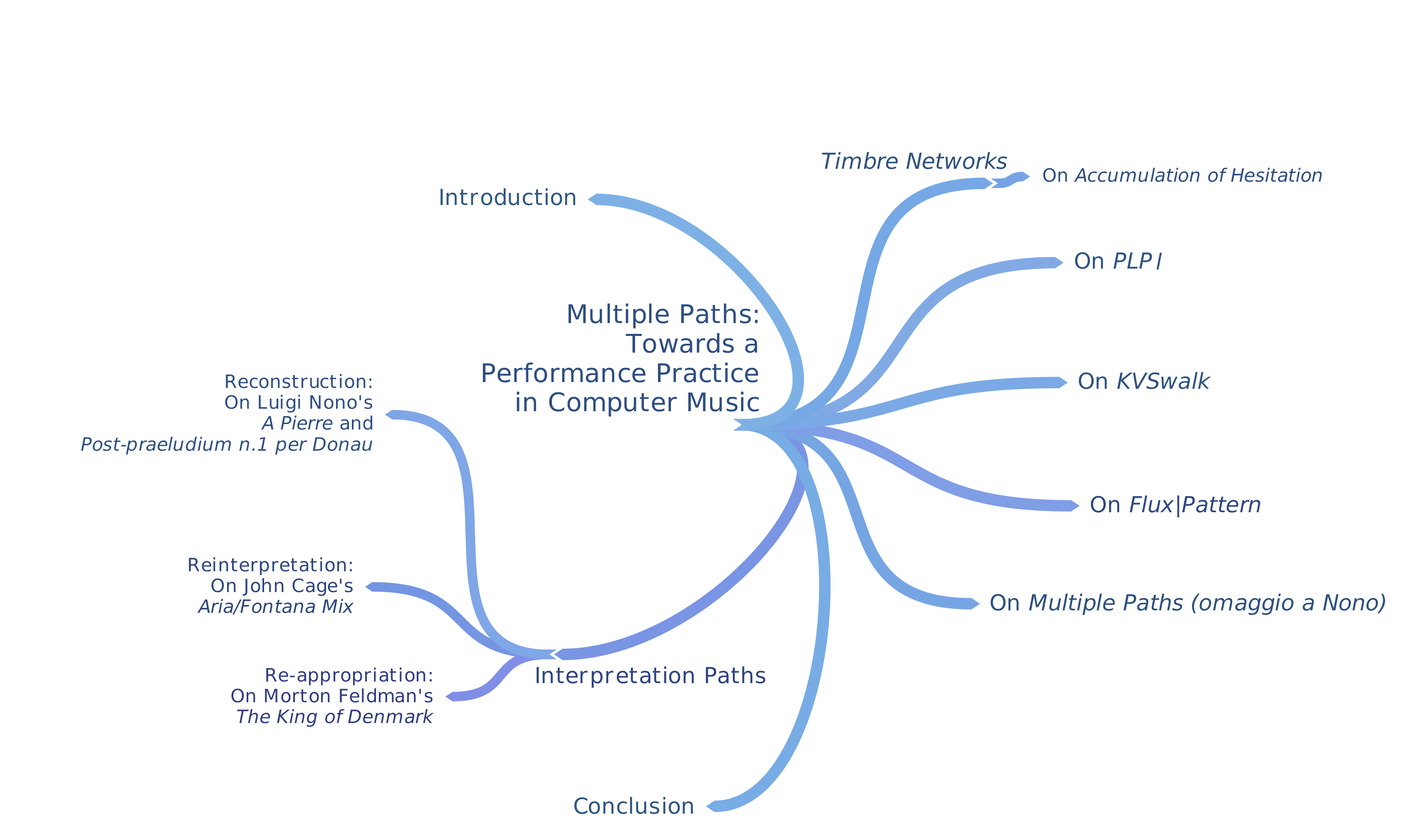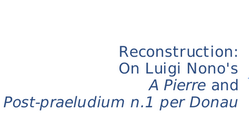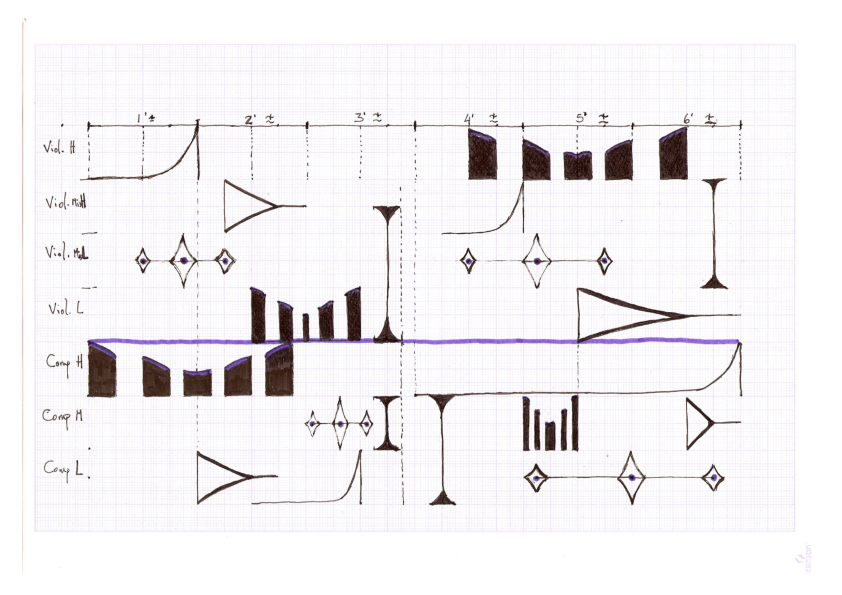On PLP I
Introduction
The creative premise behind PLP I, for electric violin and computer, began as a way to explore the grey area in computer music between the roles of composer, performer and instrument builder. In particular, it explored how the devenir1between these roles could, first, be understood as the unique quality that a computer performer should acknowledge and develop, and, second, be transferred to traditional instrumentalists as a way of creating a convergence – conceptually and logistically – between the approaches to sound production and performance of both traditional and electronic musicians.
Context
PLP I presents itself as a practical implementation of both the technical and the conceptual principles proposed by Timbre Networks (see case study Accumulation of Hesitation). It addresses, and demands from its performers, not only a flexible approach to creating and interpreting live computer music but also an understanding of the final set of parameters and interrelations that form a new score, which turns into a reference point to return to, revise and improve the outcome of the piece.
To start the process of fixing the backbone of PLP I, the behavioural limits of the sound sources (the initial nodes of the network) were defined. Later, the focus concentrated on the inner complexities of these nodes and on how they could be streamed within the complex of the network, as either control information for another fixed node (a thread between two sources) or an intrinsic richness of the node in itself (still subject to variations through performance).
1 Used in a Deleuzian fashion, usually translated as becoming. I considered that to use “becoming” could have led to a false sense of single directionality. I prefer to understand devenir (or becoming) as a generative process rather than as a one directional effect: “In a way, we must start at the end: all becomings are already molecular. […] Starting from the forms one has, the subject one is, the organs one has, or the functions one fulfils, becoming is to extract particles between which one establishes the relations of movement and rest, speed and slowness that are closest to what one is becoming, and through which one becomes. This is the sense in which becoming is the process of desire.” (Deleuze and Guattari 1987: 272–277)
In doing so, I deprive the score of its grounding role in composition, encouraging the performer to use her or his interpretative skills in a way that a traditional setup would not encourage. This makes it possible to reach a mind-set where the exploration of very well-known sets of tools (such as the mechanical skills required to play an instrument) could be reassessed repeatedly, thus influencing and advancing the skills of the computer performer, who is subjected to the same set of symbols, and therefore to an analogous interpretative challenge.
To articulate these three network relationships for PLP I (definition of sources, identities and relationships), I focused my attention on the score – or rather, on departing from the score to dive into a collaborative process which both adopted and rejected elements rooted in the conventional uses of a score in composition. Traditional music notation was replaced by a defined number of determined events, represented by graphic symbols on paper, distributed over time. Unlike in traditional notation, the graphic score used in PLP I demands that each symbol, timeframe and suggested gesture is determined anew on every reading of the initial sketches: every time I approach the score, I must assign actions (and their sounding results) to each one of the sketched symbols.
Project
PLP I uses two computer systems that can (and do) act in several different roles: they are independent sound sources, with or without the ability to be influenced by a performer, turning into a static or active node, but also serve as dedicated signal processors for other nodes, or as signal-to-control translators, working as threads between elements of the network. The use of an electric violin allowed me to define parameters that were common to both the violinist and the electronic performer, given the relative independence between sound production and perception. The definition of these parameters constituted the first step in the creative process. The next step was to create consistent identities for both instruments as sound sources and as generators of control information, and, later, to define and refine the possible transitional paths between these identities.
Reflection
Although PLP I was conceived as a process piece, in which the departure points were defined but not the destination, this conceptual ideal was rapidly challenged by traditional music conventions when dealing with the perception of time for the composer, the performer and the listener.
The interpretative freedom that a piece such as PLP I claims to offer creates a new challenge when dealing with these different sets of time. The challenge is to define a structural constraint that, while being consistent enough to allow the piece to be called “a composition”, nonetheless will not jeopardise the results achieved through the exploratory process that initially signified the primary driving force of the piece.
2 One of these musicians was Mexican guitarist Santiago Lascurain. More information about Santiago can be found at http://santiagolascurain.com/.
Originally developed in close collaboration with violinist Mieko Kanno, it was only after going through the same process with different musicians2 that this never-defined, always-mutating, grey-area-centred piece acquired its backbone.
This was achieved through limiting the actions anew during each performance to a determined interpretation of the symbols for both the traditional instrumentalist as well as for the sets of transformations and actions in charge of the computer performer.
Each version let those determined sounding actions articulate the vertical axis of the musical structure (the polyphonic relationship between sound layers), while performers dealt with a flexible understanding of the horizontal axis of the structure (the unfolding over time).
PLP sequence and performance excerpt with Santiago Lascurain, guitar. "STEIM", Amsterdam, 22 October 2009.
Excerpt of PLP I, performed by Mieko Kanno and Juan Parra Cancino. Orpheus Institute, Ghent, 18 September 2009.
Although the use of a graphic score proved an interesting way of generating a common ground for electronic and traditional instruments, I started to elaborate different strategies to tackle from different perspectives the challenge proposed with PLP, raising questions about how to recover, for composers and audiences alike, the fragility, surprise and unexpectedness that presenting music on stage is all about.
The continuing quest for possible answers to these questions led to the elaboration of new case studies, such as KVSwalk and Flux|Pattern, by proposing methods to bring the timbre palettes and the musical challenges of traditional and electronic instruments closer together.
PLP I is the result of several interpretations of parameter interdependencies, from straightforward frequency-based (range) distributions and multi-parametric articulation gestures to more precisely defined musical units and durations. Although each performance helps stabilise the expansive nature of the piece, it seems clear both to performers and to audiences listening to PLP I that the final version is an entity that might not (and should not) ever manifest itself.














